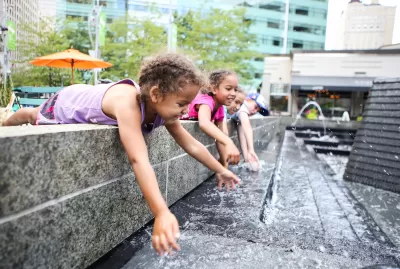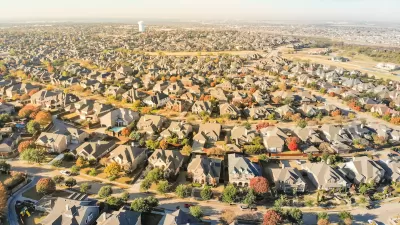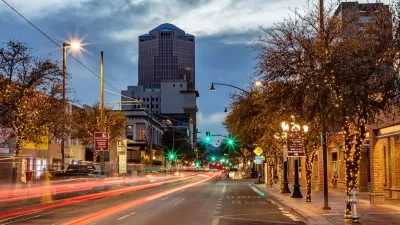For parents of small children, amenities like public restrooms or shady parks can vastly improve—or deteriorate—the experience of navigating cities.

Writing in Streetsblog USA, Barry Greene Jr. outlines five ways that the built environment fails families with young children.
The first problem, Greene writes, is shade. For example: in the warm, humid climate of Greenville, South Carolina, a new city park fails to provide almost any shade. Greene writes that parents and children need shady spots to rest during an outing.
The second issue, for Greene, is public restrooms. Most U.S. cities famously lack a robust network of public bathroom facilities, often turning a walk around a city into an urgent hunt for a bathroom. For parents of toddlers, this is another way their needs are excluded from the public built environment. “Cities are so afraid of our housing insecure that we’ve simply made it inhumane to use the bathroom. Children can’t wait — and sometimes, neither can adults.”
Greene also laments the lack of pedestrianized streets, which create safe spaces for children to run and play, as well as small-scale shops and “micro-retail storefronts” that let parents quickly access daily needs.
Greene’s fifth element of public life that doesn’t cater to parents and children is public transit. “I’ll also include family-friendly ridesharing. Currently, there’s no way to request a rideshare with a child car seat.”
Ultimately, Greene’s advice, aimed at designing cities with children in mind, can make public spaces more safe, pleasant, and accessible to all groups.
FULL STORY: Five Things Missing In The Built Environment For Families With Young Children

Alabama: Trump Terminates Settlements for Black Communities Harmed By Raw Sewage
Trump deemed the landmark civil rights agreement “illegal DEI and environmental justice policy.”

Planetizen Federal Action Tracker
A weekly monitor of how Trump’s orders and actions are impacting planners and planning in America.

The 120 Year Old Tiny Home Villages That Sheltered San Francisco’s Earthquake Refugees
More than a century ago, San Francisco mobilized to house thousands of residents displaced by the 1906 earthquake. Could their strategy offer a model for the present?

Opinion: California’s SB 79 Would Improve Housing Affordability and Transit Access
A proposed bill would legalize transit-oriented development statewide.

Record Temperatures Prompt Push for Environmental Justice Bills
Nevada legislators are proposing laws that would mandate heat mitigation measures to protect residents from the impacts of extreme heat.

Downtown Pittsburgh Set to Gain 1,300 New Housing Units
Pittsburgh’s office buildings, many of which date back to the early 20th century, are prime candidates for conversion to housing.
Urban Design for Planners 1: Software Tools
This six-course series explores essential urban design concepts using open source software and equips planners with the tools they need to participate fully in the urban design process.
Planning for Universal Design
Learn the tools for implementing Universal Design in planning regulations.
Clanton & Associates, Inc.
Jessamine County Fiscal Court
Institute for Housing and Urban Development Studies (IHS)
City of Grandview
Harvard GSD Executive Education
Toledo-Lucas County Plan Commissions
Salt Lake City
NYU Wagner Graduate School of Public Service





























